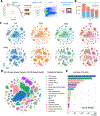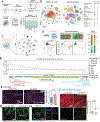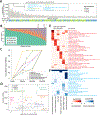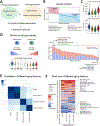Aging Fly Cell Atlas identifies exhaustive aging features at cellular resolution
- PMID: 37319212
- PMCID: PMC10829769
- DOI: 10.1126/science.adg0934
Aging Fly Cell Atlas identifies exhaustive aging features at cellular resolution
Abstract
Aging is characterized by a decline in tissue function, but the underlying changes at cellular resolution across the organism remain unclear. Here, we present the Aging Fly Cell Atlas, a single-nucleus transcriptomic map of the whole aging Drosophila. We characterized 163 distinct cell types and performed an in-depth analysis of changes in tissue cell composition, gene expression, and cell identities. We further developed aging clock models to predict fly age and show that ribosomal gene expression is a conserved predictive factor for age. Combining all aging features, we find distinctive cell type-specific aging patterns. This atlas provides a valuable resource for studying fundamental principles of aging in complex organisms.
Conflict of interest statement
Figures





Similar articles
-
Transcriptome profiling of aging Drosophila photoreceptors reveals gene expression trends that correlate with visual senescence.BMC Genomics. 2017 Nov 21;18(1):894. doi: 10.1186/s12864-017-4304-3. BMC Genomics. 2017. PMID: 29162050 Free PMC article.
-
A Single-Cell Transcriptome Atlas of the Aging Drosophila Brain.Cell. 2018 Aug 9;174(4):982-998.e20. doi: 10.1016/j.cell.2018.05.057. Epub 2018 Jun 18. Cell. 2018. PMID: 29909982 Free PMC article.
-
Slowed aging during reproductive dormancy is reflected in genome-wide transcriptome changes in Drosophila melanogaster.BMC Genomics. 2016 Jan 13;17:50. doi: 10.1186/s12864-016-2383-1. BMC Genomics. 2016. PMID: 26758761 Free PMC article.
-
Functional senescence in Drosophila melanogaster.Ageing Res Rev. 2005 Aug;4(3):372-97. doi: 10.1016/j.arr.2005.04.001. Ageing Res Rev. 2005. PMID: 16024299 Review.
-
As time flies by: Investigating cardiac aging in the short-lived Drosophila model.Biochim Biophys Acta Mol Basis Dis. 2019 Jul 1;1865(7):1831-1844. doi: 10.1016/j.bbadis.2018.11.010. Epub 2018 Nov 27. Biochim Biophys Acta Mol Basis Dis. 2019. PMID: 30496794 Free PMC article. Review.
Cited by
-
Nicotinic acetylcholine receptor signaling maintains epithelial barrier integrity.Elife. 2023 Dec 8;12:e86381. doi: 10.7554/eLife.86381. Elife. 2023. PMID: 38063293 Free PMC article.
-
Markers and mechanisms of death in Drosophila.Front Aging. 2023 Dec 12;4:1292040. doi: 10.3389/fragi.2023.1292040. eCollection 2023. Front Aging. 2023. PMID: 38149028 Free PMC article.
-
Profiling neurotransmitter-evoked glial responses by RNA-sequencing analysis.Front Neural Circuits. 2023 Aug 14;17:1252759. doi: 10.3389/fncir.2023.1252759. eCollection 2023. Front Neural Circuits. 2023. PMID: 37645568 Free PMC article.
-
Targeted single cell expression profiling identifies integrators of sleep and metabolic state.bioRxiv [Preprint]. 2024 Sep 27:2024.09.25.614841. doi: 10.1101/2024.09.25.614841. bioRxiv. 2024. PMID: 39386468 Free PMC article. Preprint.
-
Aging atlas reveals cell-type-specific effects of pro-longevity strategies.Nat Aging. 2024 Jul;4(7):998-1013. doi: 10.1038/s43587-024-00631-1. Epub 2024 May 30. Nat Aging. 2024. PMID: 38816550 Free PMC article.
References
MeSH terms
Grants and funding
LinkOut - more resources
Full Text Sources
Medical
Molecular Biology Databases

